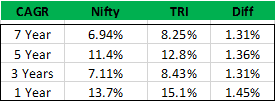As we know Nifty index represents a basket of 50 stocks. The increase or decrease in the index value gives a rough estimate of the overall capital appreciation in stocks. For this reasons, Nifty is often used as a benchmark for market performance. However, Nifty captures only the capital appreciation from equity investments and does not consider the dividend receipts. This is where Total Return Index comes into play.
The ‘Total Return Index’ of Nifty besides capturing the capital appreciation of Nifty, also captures the effect of dividend received. So think of the Total Return Index as Nifty plus the dividends received.
The difference in the ‘Compounded average growth rate’ (CAGR) between Nifty 50 and ‘Total Return Index’ of Nifty averages around 1.35%. The details are as follows -

While the percentage difference of 1.35% seems small, do remember this is a compounded return, and it does make a significant difference over a long investment period. To give you a perspective, if you choose to invest a sum of Rs.500,000/- in an instrument which returns 12% CAGR, then at the end of 10 years you will have Rs.1,552,924/- with you. However, if we add the 1.35% dividend receipt to this, then at 13.5% CAGR, Rs.500,000/- would grow to Rs.1,789,589/-.
The 1.35% extra return gives you an additional Rs.236,665/- over the 10 year investment period!